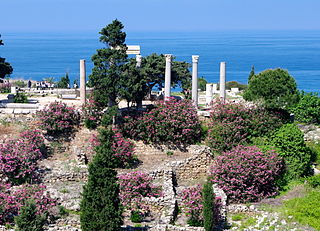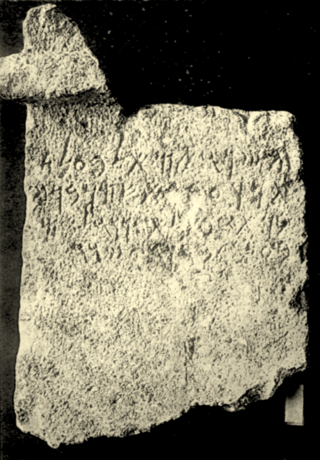
Byblos, also known as Jebeil, Jbeil or Jubayl, is the city in the Keserwan-Jbeil Governorate of Lebanon. It is believed to have been first occupied between 8800 and 7000 BC and continuously inhabited since 5000 BC, making it one of the oldest continuously inhabited cities in the world. During its history, Byblos was part of numerous civilisations, including Egyptian, Phoenician, Assyrian, Persian, Hellenistic, Roman, Fatimid, Genoese, Mamluk and Ottoman. The city is a UNESCO World Heritage Site.

The Byblos script, also known as the Byblos syllabary, Pseudo-hieroglyphic script, Proto-Byblian, Proto-Byblic, or Byblic, is an undeciphered writing system, known from ten inscriptions found in Byblos, a coastal city in Lebanon. The inscriptions are engraved on bronze plates and spatulas, and carved in stone. They were excavated by Maurice Dunand, from 1928 to 1932, and published in 1945 in his monograph Byblia Grammata. The inscriptions are conventionally dated to the second millennium BC, probably between the 18th and 15th centuries BC.

The Ahiram sarcophagus was the sarcophagus of a Phoenician King of Byblos, discovered in 1923 by the French excavator Pierre Montet in tomb V of the royal necropolis of Byblos.

Eshmunazar II was the Phoenician king of Sidon. He was the grandson of Eshmunazar I, and a vassal king of the Persian Achaemenid Empire. Eshmunazar II succeeded his father Tabnit I who ruled for a short time and died before the birth of his son. Tabnit I was succeeded by his sister-wife Amoashtart who ruled alone until Eshmunazar II's birth, and then acted as his regent until the time he would have reached majority. Eshmunazar II died prematurely at the age of 14. He was succeeded by his cousin Bodashtart.

Bodashtart was a Phoenician ruler, who reigned as King of Sidon, the grandson of King Eshmunazar I, and a vassal of the Achaemenid Empire. He succeeded his cousin Eshmunazar II to the throne of Sidon, and scholars believe that he was succeeded by his son and proclaimed heir Yatonmilk.
Kanaanäische und Aramäische Inschriften, or KAI, is the standard source for the original text of Canaanite and Aramaic inscriptions not contained in the Hebrew Bible.

The Osorkon Bust, also known as the Eliba'l Inscription is a bust of Egyptian pharaoh Osorkon I, discovered in Byblos in the 19th century. Like the Tabnit sarcophagus from Sidon, it is decorated with two separate and unrelated inscriptions – one in Egyptian hieroglyphics and one in Phoenician script. It was created in the early 10th century BC, and was unearthed c. 1881, very likely in the Temple of Baalat Gebal.
The Thrones of Astarte are approximately a dozen ex-voto "cherubim" thrones found in ancient Phoenician temples in Lebanon, in particular in areas around Sidon, Tyre and Umm al-Amad. Many of the thrones have a similar style, with cherubim heads on winged lion bodies on either side. Images of the thrones are found in Phoenician sites around the Mediterranean, including an ivory plaque from Tel Megiddo (Israel), a relief from Hadrumetum (Tunisia) and a scarab from Tharros (Italy).

The Yehawmilk stele, de Clercq stele, or Byblos stele, also known as KAI 10 and CIS I 1, is a Phoenician inscription from c.450 BC found in Byblos at the end of Ernest Renan's Mission de Phénicie. Yehawmilk, king of Byblos, dedicated the stele to the city’s protective goddess Ba'alat Gebal.
The Athenian Greek-Phoenician inscriptions are 18 ancient Phoenician inscriptions found in the region of Athens, Greece. They represent the second largest group of foreign inscriptions in the region after the Thracians. 9 of the inscriptions are bilingual Phoenician-Greek and written on steles. Almost all of them bear the indication of the deceased's city of origin, not just the more general designation of their ethnicity, like most other non-Greek inscriptions in the region.

The royal necropolis of Byblos is a group of nine Bronze Age underground shaft and chamber tombs housing the sarcophagi of several kings of the city. Byblos is a coastal city in Lebanon, and one of the oldest continuously populated cities in the world. The city established major trade links with Egypt during the Bronze Age, resulting in a heavy Egyptian influence on local culture and funerary practices. The location of ancient Byblos was lost to history, but was rediscovered in the late 19th century by the French biblical scholar and Orientalist Ernest Renan. The remains of the ancient city sat on top of a hill in the immediate vicinity of the modern city of Jbeil. Exploratory trenches and minor digs were undertaken by the French mandate authorities, during which reliefs inscribed with Egyptian hieroglyphs were excavated. The discovery stirred the interest of western scholars, leading to systematic surveys of the site.

Baalshillem I was a Phoenician King of Sidon, and a vassal of the Achaemenid Empire. He was succeeded by his son Abdamon to the throne of Sidon.

The Abdmiskar cippus is a white marble cippus in obelisk form discovered in Sidon, Lebanon, dated to 300 BCE. Discovered in 1890 by Joseph-Ange Durighello.

The Byblos altar inscription is a Phoenician inscription on a broken altar discovered around 1923 during the excavations of Pierre Montet in the area of the Byblos temples. It was discovered outside the temples and tombs, a few meters from the hypocausts, in a modern wall.

The Abibaʻl Inscription is a Phoenician inscription from Byblos on the base of a throne on which a statue of Sheshonq I was placed. It is held at the Vorderasiatisches Museum Berlin.

The Safatba'al inscription or the Shipitbaal inscription is a Phoenician inscription found in Byblos in 1936, published in 1945.

The Yehimilk inscription is a Phoenician inscription published in 1930, currently in the museum of Byblos Castle.

The Abda sherd graffito is a Phoenician inscription on a two small connecting fragment of a large vase, dating to c. 900 BC.

The Batnoam inscription is a Phoenician inscription on a sarcophagus. It is dated to c. 450-425 BCE.

The Byblos bronze spatulas are a number bronze spatulas found in Byblos, two of which were inscribed. One contains a Phoenician inscription and one contains an inscription in the Byblos syllabary.























